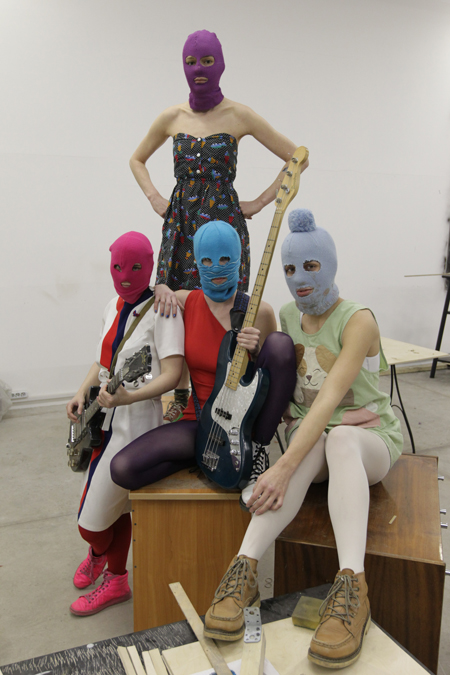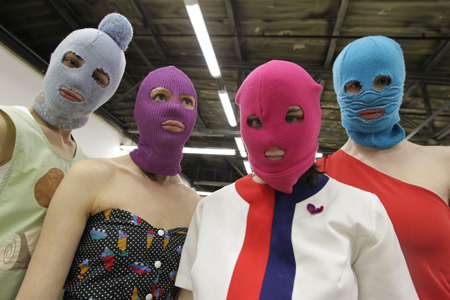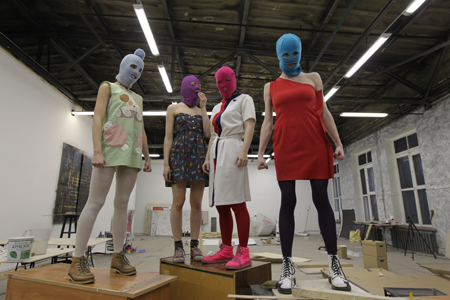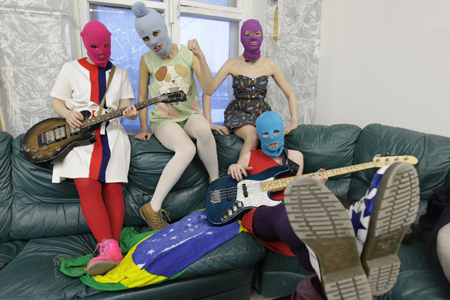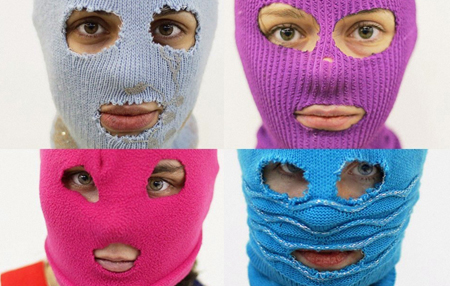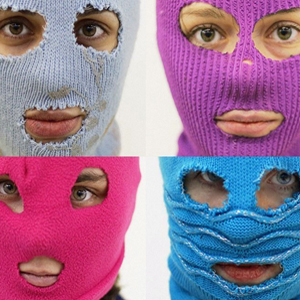Pussy Riot – A Punk Prayer HotDocs13 Review
Pussy Riot: A Punk Prayer
The Pulpit, The Punks and The President
“Pussy Riot: A Punk Prayer”. A Roast Beef Productions. Directed by Mike Lerner and Maksim Pozdorovkin.
“Pussy Riot: A Punk Prayer” originally premiered at the 2013 Sundance Film Festival winning a World Cinema Documentary Special Jury Award for “Punk Spirit”. Intended for anyone who heard the term “Free Pussy Riot” and didn’t know what a ‘Pussy Riot’ was.
“Pussy Riot: A Punk Prayer” is a fast paced, superbly executed, activism documentary which tells a compelling story about the Moscow based feminist punk-rock group/collective, Pussy Riot. Accompanied by a thrashing soundtrack, including tracks from Peaches, and Pussy Riot, ‘A Punk Prayer’ throws a entertaining punch of activism, feminism and punk rock at you in a mere 86 minutes. It documents the February 21st, 2012 highly publicized arrest and subsequent trial of Pussy Riot’s founding members, Nadezhda (Nadia) Tolokonnikova, Yekaterina (Katia) Samutsevich and Maria (Masha) Alyokhina.Their crime was a 30-second anti-Vladmir Putin Punk Prayer performance in the Russian Orthodox Cathedral of Christ the Savior in Moscow. A Punk Prayer follows Pussy Riot members, Nadia, Katia and Masha in the months surrounding their highly publicized performance, arrest and trial. The doc utilizes home videos, Youtube footage of Pussy Riot demonstrations, police footage of the girls, publicly available footage from their court proceeding and interviews with each member’s family.
The interviews with the girls’ parents are exceptionally shot, compelling and give a better sense of where these girls found their spirit for activism growing up in modern Russia. Through the eyes of their families and supporters Pussy Riot becomes more than a protest group: it becomes art and a beacon of hope that change can happen. Filmed in Moscow, images of the band performing “Putin Zassal” (which loosely translates to ‘Putin Pissed himself”) in The Red Square is a particularly powerful scene. Set against the backdrop of Russia’s stunning scenery, Pussy Riot performs clad in brightly coloured Balaclavas, bright tights and bare arms in the snow, setting off flare guns as they scream and sing. This creates a particularly iconic image of Russia’s old ideologies and values juxtaposed against new.
The directors’ original intent for ‘A Punk Prayer’ was to follow around the members of Pussy Riot as they performed their shock-tactic, punk music protests for gay, women and migrant rights in symbolic locations around Russia. Pussy Riot’s guerilla performances were taped happening in central storefronts and in theRed Square (the area that separates the President Putin’s living quarters from the main area of Russia). However, when three of the members were arrested and charged with “premeditated hooliganism performed by an organized group of people motivated by religious hatred or hostility” after their performance in theRussian Orthodox Cathedral of Christ the Savior the tone of the film takes a turn.
No longer just showcasing one punk groups’ desire for fair human rights, but also portraying a government whose heavy-handed ruling hasn’t changed much since the fall of the Soviet Union. The highly publicized trial and persecution of the members appears to be a message from the Government, making an example of any Putin opposition.
This documentary’s strength comes from its ability to force the viewer to question what each side of the opposition has to say. One of the burning questions raised is, “Why is the Russian government so afraid of Pussy Riot?”
In Russia, the Church and the State are constitutionally suppose to be separate, however, in practice they’re mutually invested in one another. Were the girls arrested because they disrupted a holy ceremony in a country haunted by religious suppression or was it because they were protesting against their President?Putin is a highly scrutinized President whose opposition calls his tactics “undemocratic.” He is a President who is widely known to be moving the country into an authoritarian regime—some would even go so far as to call him a dictator. Were the girls held without bail for a year for causing a disruption to the peace? Or is this an example of how the Russian government and Putin are trying to stamp out any opposition to his rule?
Lerner and Pozdorovkin make an honest attempt to provide a well-rounded, unbiased, explanation of the formation of Pussy Riot. It is a brave undertaking after the majorly contested presidential election that returned Putin to the Kremlin. It follows Pussy Riot’s rising popularity among the liberal population of Russia and showcases their public protests against Putin’s sixteen year managed ‘democracy’. Through filmed demonstrations and interviews with Pussy Riot’s family members we see the frustration and dedication of these activists fighting for basic human rights.
Lerner and Pozdorokin try to provide objectivity by touching on Russia’s haunted history of State Atheism, and interviewing devoted believers of the Russian Orthodox Church. Through this effort of symmetry the directors construct a portrait of how divided Russia’s beliefs are when it comes to issues surrounding religion, gender equality, gay rights, public protest, and performance art. This balancing act allowed me to feel immense empathy for the people of Russia—who on both sides of the coin seem to just want acceptance for their beliefs, whatever that may entail.
Truth to be told, before Pussy Riot: A Punk Prayer, I didn’t know much about Pussy Riot outside the excerpts and gossip whisperings I heard from friends. They’re a punk group. They’re protesters. They got arrested for performing punk protest songs in a church and scaring a bunch of old ladies. Their President is a dictator ‘asshole’ who doesn’t like protest and will imprison anyone who challenges him. So needless to say I expected to see just that. What I didn’t realize is exactly WHAT this group was protesting, and how vastly different Russia’s viewpoints on human rights is from our Western sensibilities. I found this information disheartening. Why is conducting a Gay Pride parade illegal? How is it Russia’s President/ former Prime Minister/ Chairman of United Russia has managed to rule Russia since 1999? Was it a coincidence that his official opposition was arrested during the Pussy Riot trial?
I left Pussy Riot: A Punk Prayer not so much contemplating the film, but rather thinking about its subjects, one of the powers of documentary films. I was feeling contemplative about the actions of Nadia, Masha, and Katia. Was performing such a public display of activism worth getting arrested for? Surely it couldn’t have been the most effective way to cause change. How can you do so behind bars? And days later, while still contemplating this it struck me and I almost felt stupid for not considering this earlier. A middle-class, 20 something white girl in Canada knew about their cause, thought about their cause, wrote about their cause. Conducting an act to support your beliefs and having it resonate around the globe years later? I’d say that’s a pretty effective way to create change!
Highly recommended.
-Lauren Schell

